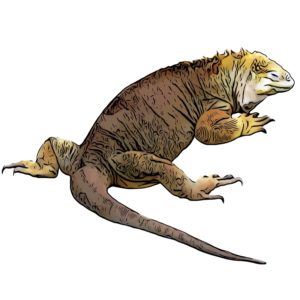
Identification
Unmistakeable. Distribution does not ovevrlap with Santa Fe Land Iguana and can easily be distinguished from both Marine and Pink Land Iguana by its yellow color. This being siad, the species is known to hybridise with Marine Iguana at locations such as South Plaza Island where the two co-occur.
Description
An overall yellowish orange iguana with a brownish red to dark brown back. Males are generally larger, have thicker tails, more pronounced dorsal crests and larger, more blunted heads than females.
Galapagos Distribution
Found across Isabela, Fernandina, Baltra, North Seymour and South Plaza Islands. There is also a population on NW Santa Cruz and it has been re-introduced to Santiago. The best places to look for it are South Plaza and North Seymour.
Global Distribution
The Galapagos Land Iguana is endemic to the Galapagos
Status in the Galapagos
Locally common to rare endemic resident.
Conservation
Vulnerable. With a total population of roughly 10, 000 mature individuals, this species is ranked as ‘vulnerable’. It has been extripated from Rabida and Santiago and populations across Santa Cruz and southern Isabela have been greatly reduced. It is threatened by invasive predators such as cats, dogs, pigs and rats that prey on its eggs young.


